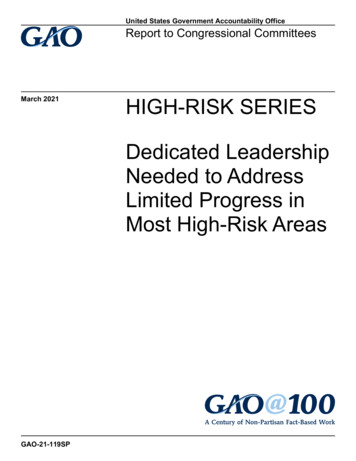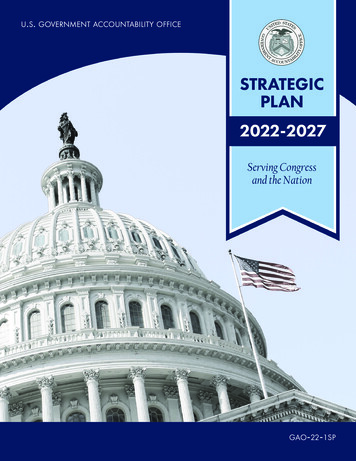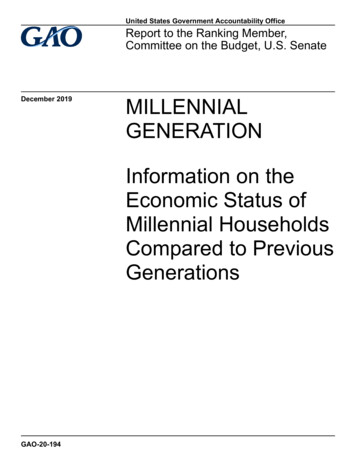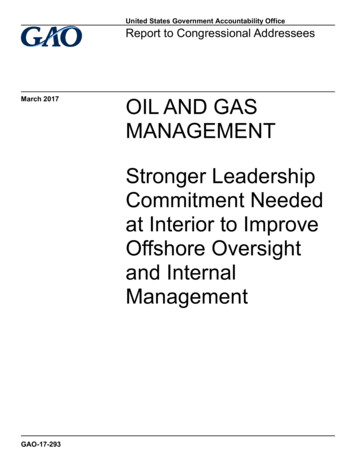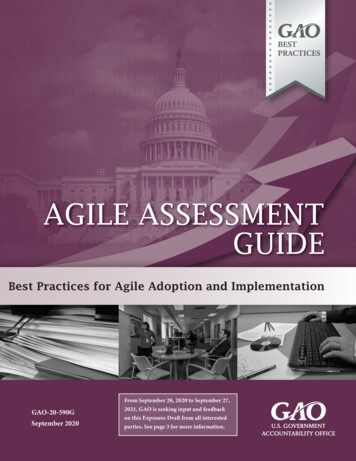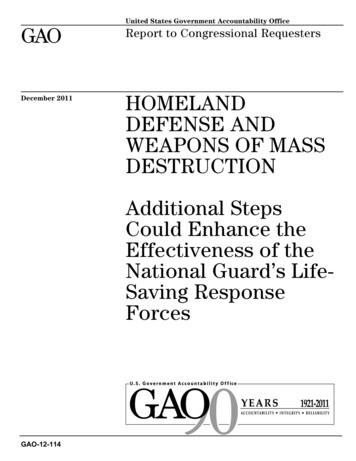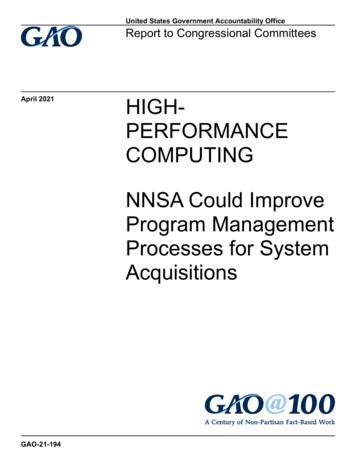
Transcription
United States Government Accountability OfficeReport to Congressional CommitteesApril 2021HIGHPERFORMANCECOMPUTINGNNSA Could ImproveProgram ManagementProcesses for SystemAcquisitionsGAO-21-194
April 2021HIGH-PERFORMANCE COMPUTINGNNSA Could Improve Program ManagementProcesses for System AcquisitionsHighlights of GAO-21-194, a report tocongressional committeesWhy GAO Did This StudyNNSA is responsible for maintainingthe nation's nuclear stockpile. Toanalyze the performance, safety, andreliability of nuclear weapons, itacquires high-performance computing(HPC) systems to conduct simulations.The latest system, El Capitan, isexpected to be fully deployed by March2024.The committee report accompanyingthe Energy and Water Developmentand Related Agencies AppropriationsAct, 2019, includes a provision forGAO to review NNSA’s managementof its Advanced Simulation andComputing program. This reportexamines, among other things, (1) theextent to which NNSA’s AOA processfor the El Capitan acquisition met bestpractices and followed agency policyand guidance and (2) the extent towhich NNSA is implementing selectedacquisition best practices in carryingout the El Capitan acquisition program.GAO reviewed documents andinterviewed NNSA officials andlaboratory representatives involved incarrying out the AOA and acquisitionprocesses.What GAO FoundThe National Nuclear Security Administration’s (NNSA) analysis of alternatives(AOA) process for its 600 million El Capitan HPC acquisition did not fully followagency policy that states that AOA processes should be consistent with GAObest practices, where possible, and any deviations must be justified anddocumented. According to GAO best practices, a reliable AOA process shouldmeet four characteristics: it should be comprehensive, well documented,unbiased, and credible. As seen in the table, the AOA process for El Capitanpartially met one of these characteristics and minimally met the other three.NNSA did not justify or document the deviations from these best practices, asrequired by NNSA policy. GAO also found that the AOA process was conductedby the contractor that manages the El Capitan acquisition program, contrary toagency policy and guidance stating that AOAs should be conducted by anindependent entity. Without following AOA best practices where possible;justifying and documenting any deviations; and ensuring AOA processes areconducted by an independent entity, as required, NNSA cannot be assured of areliable assessment of options for meeting critical mission needs.Extent to Which the National Nuclear Security Administration (NNSA) Met the Characteristicsof a Reliable Analysis of Alternatives (AOA) Partially metWelldocumentedUnbiasedMinimally metCredibleMinimally metMinimally metWhat GAO RecommendsGAO recommends that NNSA (1)ensure that future HPC acquisitionprograms follow AOA best practices,where possible, and justify anddocument any deviations consistentwith policy; (2) ensure that anindependent entity conducts futureAOA processes; and (3) update andmaintain acquisition programdocuments to include El Capitanrequirements for the ongoingacquisition. NNSA generally concurredwith these recommendations.View GAO-21-194. For more information,contact Allison Bawden at (202) 512-3841 orbawdena@gao.gov or Kevin Walsh at (202)512-8151 or walshk@gao.gov.Example ofdeviationCost estimates are incomplete and didnot follow best practices.The alternatives’ descriptions are notdetailed enough for a robust analysis.NNSA had a predetermined solution,acquiring an HPC system, beforeperforming the AOA process.The selection criteria appear to havebeen written for the preferred alternative.Source: GAO analysis of NNSA information. GAO-21-194GAO found that, in the second year of the El Capitan acquisition program’s 5year acquisition life cycle, NNSA has fully implemented selected key practicesrelated to program monitoring and control. However, NNSA has only partiallyimplemented key practices related to requirements management. Specifically, ElCapitan program officials did not update and maintain acquisition programdocuments to include current requirements. NNSA officials stated that once theprogram developed its program plan early in the program’s life cycle, they did notrequire the program to update and maintain that program plan. However, NNSA’sown program management policy requires programs to update programdocuments throughout the duration of the program. Without updating andmaintaining El Capitan program documents to include current requirements,NNSA officials may be limited in their ability to ensure that all missionrequirements are met.United States Government Accountability Office
ContentsLetter1BackgroundThe El Capitan Acquisition Program Will Cost Significantly Morethan Previous HPC System Acquisition Programs Due to aPlanned Large Increase in Computer Performance andCapacityNNSA’s AOA Process for the El Capitan Acquisition Program DidNot Fully Meet Best Practices or Follow Agency Policy andGuidanceNNSA Is Fully Implementing Selected Acquisition Best Practicesfor Program Monitoring but Not for Requirements ManagementConclusionsRecommendations for Executive ActionAgency Comments620242626Appendix IObjectives, Scope, and Methodology28Appendix IIGAO Review of the National Nuclear SecurityAdministration’s (NNSA) Analysis of Alternatives(AOA) Process for El Capitan33Appendix IIIComments from the Department of Energy42Appendix IVGAO Contact and Staff Acknowledgments471315TablesTable 1: NNSA’s Major High-Performance Computing SystemAcquisitions for the Advanced Simulation and ComputingProgramTable 2: Analysis of Alternatives Policy, Guidance, and BestPractices for the Advanced Simulation and ComputingHigh-Performance Computing System AcquisitionProgramsTable 3: Cost and Performance of NNSA’s Four Latest HighPerformance Computing (HPC) SystemsPage i81014GAO-21-194 High-Performance Computing
Table 4: GAO’s Review of the National Nuclear SecurityAdministration’s (NNSA) Analysis of Alternatives (AOA)Process for the El Capitan Acquisition ProgramaTable 5: GAO’s Assessment of the National Nuclear SecurityAdministration’s (NNSA) Implementation of Five SelectedProgram Monitoring and Control Key Practices for the ElCapitan ProgramTable 6: GAO’s Assessment of the National Nuclear SecurityAdministration’s (NNSA) Implementation of RequirementsManagement Key Practices for the El Capitan ProgramTable 7: Review of the National Nuclear Security Administration’s(NNSA) Analysis of Alternatives (AOA) Process AgainstGAO Best PracticesaTable 8: Final Assessment of the El Capitan Analysis ofAlternatives (AOA) Process Against Characteristics of aHigh-Quality, Reliable AOA Process1621233440FiguresFigure 1: Advanced Simulation and Computing Program Budgetfor Fiscal Year 2020Figure 2: El Capitan Program Time Line and Key Milestones, as ofNovember 2020Page ii713GAO-21-194 High-Performance Computing
AbbreviationsAOAASCCEPEanalysis of alternativesAdvanced Simulation and ComputingNational Nuclear Security Administration Office of CostEstimating and Program Evaluation CMMICapability Maturity Model Integration CMMI -ACQ Capability Maturity Model Integration for AcquisitionDOEDepartment of EnergyExaFLOPSone quintillion floating point operations per secondFLOPSfloating point operations per secondHPChigh-performance computingLCCElife cycle cost estimateLivermoreLawrence Livermore National LaboratoryLos Alamos Los Alamos National LaboratoryNA-MBNational Nuclear Security Administration Office ofManagement and BudgetNAPNational Nuclear Security Administration PolicyNNSANational Nuclear Security AdministrationSandiaSandia National LaboratoriesTFLOPSteraFLOPS, or 1 trillion floating point operations persecondTiBtebibyteThis is a work of the U.S. government and is not subject to copyright protection in theUnited States. The published product may be reproduced and distributed in its entiretywithout further permission from GAO. However, because this work may containcopyrighted images or other material, permission from the copyright holder may benecessary if you wish to reproduce this material separately.Page iiiGAO-21-194 High-Performance Computing
Letter441 G St. N.W.Washington, DC 20548April 29, 2021The Honorable Dianne FeinsteinChairThe Honorable John KennedyRanking MemberSubcommittee on Energy and Water DevelopmentCommittee on AppropriationsUnited States SenateThe Honorable Marcy KapturChairwomanThe Honorable Mike SimpsonRanking MemberSubcommittee on Energy and Water Development, and Related AgenciesCommittee on AppropriationsHouse of RepresentativesSince 1992, the United States has observed a moratorium on nuclearexplosive testing, based on the national security assessment that it doesnot need to conduct such testing to ensure the safety, security, andeffectiveness of the nuclear weapons it maintains. As a result, theDepartment of Energy’s (DOE) National Nuclear Security Administration(NNSA), through its Stockpile Stewardship Program, maintains andmodernizes the nuclear stockpile without relying on nuclear testing. 1NNSA’s Advanced Simulation and Computing (ASC) program is anessential element of the Stockpile Stewardship Program. 2 It develops1TheStockpile Stewardship Program was established in 1995 and includes a series ofwhat DOE initially called “campaigns,” which DOE defined as technically challenging,multiyear, multifunctional efforts to develop and maintain the critical capabilities needed tocontinue assessing the safety and reliability of the nuclear stockpile into the foreseeablefuture without underground testing. See GAO, Nuclear Weapons: Preliminary Results ofReview of Campaigns to Provide Scientific Support for the Stockpile StewardshipProgram, GAO-05-636R (Washington, D.C.: Apr. 29, 2005). More recently, NNSA hasorganized its Stockpile Stewardship work around science, technology, and engineeringprograms, each of which may have several campaign-like initiatives. See Department ofEnergy, National Nuclear Security Administration, Fiscal Year 2020 Stockpile Stewardshipand Management Plan (Washington, D.C.: July 2019).2TheASC program was established in 1996 as the Accelerated Strategic ComputingInitiative, which officially ended in fiscal year 2004 and became the Advanced Simulationand Computing program in fiscal year 2005.Page 1GAO-21-194 High-Performance Computing
modeling and simulation capabilities and deploys high-performancecomputing (HPC) platforms to analyze and predict the performance,safety, and reliability of nuclear weapons and to help certify theirfunctionality in the absence of nuclear testing. 3 Since its establishment in1996, NNSA’s ASC program has developed and deployed some of theworld’s most powerful computers, according to the TOP500 list. 4Three contractor-managed and -operated national laboratories, whichNNSA oversees, develop the computing, modeling, and simulation toolsfor the ASC program: Los Alamos National Laboratory (Los Alamos) inNew Mexico; Sandia National Laboratories (Sandia) in New Mexico andCalifornia; and Lawrence Livermore National Laboratory (Livermore) inCalifornia. NNSA works with these labs to manage the acquisition of theHPC systems on which the tools run. As part of this process, the labshelp develop requirements for modeling and simulation capabilities;conduct an analysis of alternatives (AOA) process for each acquisition,which is intended to identify the best way to meet those requirements;and manage contracts with vendors to supply HPC capabilities.NNSA’s latest HPC system acquisition is named El Capitan and isrequired by the statement of work associated with the contract for itsacquisition to provide a greater-than-10-fold increase in computationalperformance, as measured by the peak operational speed, over thecurrent highest-performing ASC HPC system—Sierra. El Capitan will bethe ASC program’s first exascale computing system. As such, it is part of3High-performancecomputing generally is the use of aggregated computing power toachieve much higher performance than that of typical desktop computers or workstationsto solve large problems in science, engineering, or business. The performance of acomputer is a function of characteristics such as response time, throughput, and executiontime.4TheTOP500 list is a project started in 1993 to rank the most powerful computing systemsaround the world. The rankings are based on system performance against the LINPACKbenchmark. The performance information is self-reported, and the authors of the listattempt to verify the information but cannot guarantee its accuracy. The LINPACKbenchmark is used to measure the actual performance of a computing system by runninga system of linear equations on the system. This allows uniformity in reportingperformance across all systems. However, no single benchmark or method of measuringsystem performance can provide the overall performance of a system.Page 2GAO-21-194 High-Performance Computing
DOE’s Exascale Computing Initiative 5 that seeks to meet NNSA’s goal ofachieving an exascale HPC system by the early 2020s to support itsnuclear weapons stockpile and nonproliferation activities as included in itsstrategic vision. 6 According to an NNSA document, the need to assessthe performance of current and future weapons systems against thegrowing capabilities of adversaries to use advanced defensive systemsrequires computing capabilities that will exceed those provided bynonexascale computing systems. NNSA’s HPC systems will be used tosimulate nuclear weapons designs that may differ from the weaponsdesigns that were historically tested due to changes such as designmodifications or aging effects, according to an NNSA document.The House committee report accompanying the Energy and WaterDevelopment and Related Agencies Appropriations Act, 2019, includes aprovision for us to review NNSA’s management of the ASC program toevaluate NNSA’s process for setting requirements and evaluatingalternatives and to identify the estimated costs of NNSA’s future systemscompared with previous acquisitions. 7 Our objectives were to examine (1)how the cost of NNSA’s El Capitan acquisition program will compare withthe costs of previous HPC acquisition programs, (2) the extent to whichNNSA’s AOA process for the El Capitan acquisition program met bestpractices and followed agency policy and guidance, and (3) the extent towhich NNSA is implementing selected acquisition best practices incarrying out the El Capitan acquisition program.To address our first objective, we reviewed cost and budget documentsfor the ASC HPC acquisition programs, comparing the cost and budgetfor El Capitan against the cost and budget for previous HPC acquisitionprograms. We also interviewed NNSA officials and laboratoryrepresentatives about the costs of the acquisition programs.5Aspart of the 2015 interagency National Strategic Computing Initiative, DOE’s Office ofScience and NNSA partner on the Exascale Computing Initiative to develop exascalesystems with applications to address next-generation science, engineering, and dataproblems. An exascale computing system is one that is capable of at least a quintillion (orbillion billion) floating point operations per second (FLOPS), or one exaFLOPS.6National Nuclear Security Administration, Strategic Vision: Strengthening Our Nationthrough Nuclear Security (Washington, D.C.: December 2018).7H.Rep. No. 115-697 at 111 (2018) (accompanying Pub. L. No. 115-244, 132 Stat. 2898(2018)).Page 3GAO-21-194 High-Performance Computing
To address our second objective, we reviewed the AOA documentationfor the El Capitan acquisition program 8 against GAO’s best practices foran AOA process. 9 These practices are grouped into four characteristicsthat identify a reliable AOA process—that is, a process that iscomprehensive, well documented, unbiased, and credible. 10 To determinethe extent to which NNSA’s AOA process met each of the fourcharacteristics, we assigned a rating of “not met,” “minimally met,”“partially met,” “substantially met,” or “fully met” for each best practiceassociated with a characteristic. 11 We then combined the ratings for thebest practices to determine the extent to which the AOA process meteach of the four characteristics, assigning an overall rating of not met,minimally met, partially met, substantially met, or fully met.We also reviewed DOE’s and NNSA’s Office of Defense Programsprogram management and AOA policy and guidance, which provide amanagement framework for the El Capitan acquisition program, andinterviewed NNSA officials and laboratory representatives to determine8LawrenceLivermore National Laboratory, Mission Need Package (CD-0) for ASC ElCapitan System Acquisition Project (Livermore, CA: November 2017); and DraftConceptual Baseline/Execution Readiness Package (CD-1/3a) for the NNSA ASC ElCapitan Advanced Technology System Procurement (Livermore, CA: January 2018).9Forthis report, we used the best practices for an AOA process as identified in GAO,Amphibious Combat Vehicle: Some Acquisition Activities Demonstrate Best Practices;Attainment of Amphibious Capability to Be Determined, GAO-16-22 (Washington, D.C.:Oct. 28, 2015). Subsequent to our review, these best practices were updated in GAO,Cost Estimating and Assessment Guide, GAO-20-195G (Washington, D.C.: March 2020).The differences between the two versions are minor and did not impact the results of ourreview.10A comprehensive AOA process is one that ensures that the mission need is defined in away to allow for a robust set of alternatives, that all analyzed alternatives have beenconsidered, and that each alternative is analyzed thoroughly over the program’s entire lifecycle. A well-documented AOA process is one that is thoroughly described in a singledocument, including all source data, clearly detailed methodologies, calculations andresults, and where the selection criteria are explained. An unbiased AOA process is onethat does not have a predisposition toward one alternative over another and is based ontraceable and verifiable information. A credible AOA process is one that thoroughlydiscusses the limitations of the analysis resulting from the uncertainty that surrounds boththe data and the assumptions for each alternative.11Theratings were assigned as follows: not met—provided no evidence that satisfies anyof the best practice or characteristic; minimally met—provided evidence that satisfies asmall portion of the best practice or characteristic; partially met—provided evidence thatsatisfies about half of the best practice or characteristic; substantially met—providedevidence that satisfies a large portion of the best practice or characteristic; and fully met—provided complete evidence that satisfies the best practice or characteristic.Page 4GAO-21-194 High-Performance Computing
the extent to which the AOA process for the El Capitan acquisitionprogram followed applicable agency policy and guidance. 12 Theseinterviews were conducted with officials from NNSA’s Office of AdvancedSimulation and Computing and Institutional Research and DevelopmentPrograms under NNSA’s Office of Defense Programs, which is theprogram office for the El Capitan acquisition program; NNSA’s Office ofManagement and Budget, which is responsible for leading NNSA-initiatedAOA processes; and NNSA’s Office of Cost Estimating and ProgramEvaluation, which provides independent analyses, including costestimating, alternatives assessment, and program performanceevaluation for NNSA. More detail about our review of the El Capitan AOAprocess can be found in appendix II.For our third objective, we reviewed the Software Engineering Institute’sCapability Maturity Model Integration for Acquisition (CMMI -ACQ) andselected two areas—program monitoring and control and requirementsmanagement—that represented information technology acquisition areasof particular importance to the El Capitan acquisition program. 13 Next,using our professional judgment, we selected the best practices related tothose two areas that were most applicable to the El Capitan acquisitionprogram when factoring in that the acquisition is in early stages. Wereviewed the extent to which NNSA is implementing the selected bestpractices applicable to early stage acquisitions by reviewing El Capitanacquisition program documents, such as its risk registers, conceptualbaseline document, and acquisition plan, and assessed the documentsagainst the best practices. Based on this analysis, we assessed eachpractice area as “implemented,” “partially implemented,” or “notimplemented.” 14 We also interviewed officials from NNSA and12Department of Energy, Program and Project Management for the Acquisition of CapitalAssets, DOE Order 413.3B (Change 5) (Washington, D.C.: April 2018); Department ofEnergy, Office of Defense Programs, DP Program Execution Instruction: NA-10 ProgramManagement Tools and Processes, (Washington, D.C.: Rev. 1, October 2015, and Rev. 2,June 2019); Department of Energy, Defense Programs Analysis of Alternatives Guidance(Washington, D.C.: January 2017); and Business Operating Procedure 03.07: Analysis ofAlternatives (Washington, D.C.: March 2016).13Software Engineering(CMMI -ACQ), VersionInstitute, Capability Maturity Model Integration for Acquisition1.3 (Pittsburgh, PA: November 2010).14Theassessments were assigned as follows: implemented—NNSA provided completeevidence that showed it fully satisfied the practice area; partially implemented—NNSAprovided evidence that showed it partially satisfied the practice area; or notimplemented—NNSA did not provide evidence that showed it satisfied any of the practicearea.Page 5GAO-21-194 High-Performance Computing
representatives from Livermore involved in the El Capitan acquisitionprogram.We conducted this performance audit from March 2019 to April 2021 inaccordance with generally accepted government auditing standards.Those standards require that we plan and perform the audit to obtainsufficient, appropriate evidence to provide a reasonable basis for ourfindings and conclusions based on our audit objectives. We believe thatthe evidence obtained provides a reasonable basis for our findings andconclusions based on our audit objectives.BackgroundNNSA’s HPC SystemAcquisitionsIn 1993, DOE established the Stockpile Stewardship Program to improvethe science and technology for assessing an aging nuclear weaponsstockpile without underground nuclear testing. NNSA’s ASC program, anintegral part of this program, develops simulation capabilities to predictthe performance, safety, and reliability of nuclear weapons and to helpcertify their functionality. As part of this effort, NNSA’s national labs—LosAlamos, Sandia, and Livermore—acquire HPC systems to support thesoftware used for running simulations. NNSA leverages each HPC as ashared resource among the three labs, regardless of the location of theHPC system. For fiscal year 2020, funding for the ASC programconstituted about 6 percent of NNSA’s total funding for weaponsactivities. According to an NNSA official, funding for all ASC HPC systemacquisitions comes from the Computational Systems and SoftwareEnvironment portion of the ASC program’s overall costs (see fig. 1).Page 6GAO-21-194 High-Performance Computing
Figure 1: Advanced Simulation and Computing Program Budget for Fiscal Year 2020Since 1996, NNSA has acquired 13 major HPC systems to support itssimulation efforts and is in the process of acquiring two more—Crossroads and El Capitan. Generally, the computational performance ofNNSA’s HPC systems has increased over time. However, NNSA plans fora very significant increase in computational performance with its ElCapitan system acquisition program. 15 For example, the statement ofwork requires El Capitan’s peak operational speed—one key performancemeasure—to be more than 10 times that of the most recent systemcurrently in use—Sierra. Additionally, the statement of work requires ElCapitan’s memory capacity to increase by more than six times that ofSierra. Table 1 identifies NNSA’s major HPC system acquisitions for theASC program.15There are many ways to measure computational performance, such as the speed atwhich a system calculates floating point operations per second, known as FLOPS, or thespeed at which a system can run graphics-intensive applications. Performance alsodepends on a number of other factors, such as the amount and speed of memory, networkperformance, and how well the computer codes utilize the system hardware.Page 7GAO-21-194 High-Performance Computing
Table 1: NNSA’s Major High-Performance Computing System Acquisitions for the Advanced Simulation and ComputingProgramTheoretical peakoperational speed(TFLOPS)aMemorycapacity (TiB)bYears ofoperationNational laboratory wherethe system was, is, orwill be locatedRed31.21996-2005SandiaBlue Mountain31.51998-2004Los AlamosBlue Pacific41.51998-2004Lawrence Livermore1262000-2004Lawrence Livermore20 162002-2008Los Alamos41; 284 (upgraded) 762005-2012SandiaSystemnameWhiteQRed StormPurple93502005-2010Lawrence LivermoreBlue Gene/L367; 596 (upgraded)32; 48 (upgraded)2005-2012Lawrence LivermoreRoadrunner1,3801042009-2013Los Alamos1,3742862011-2016Los Alamos20,1321,5362012-2020Lawrence Livermore2,0702016-2022cLos Alamos125,7121,3202018-2023cLawrence LivermoreTBAeTBAe2022-2027Los Alamos 1,500,000TBAe2023-2029Lawrence dElCapitandSource: National Nuclear Security Administration (NNSA). GAO-21-194A TFLOPS or teraFLOP per second is a unit of computing speed equal to one trillion (1012) floatingpoint operations per second (FLOPS).aA tebibyte (TiB) is a unit of digital information storage that equals 240 bytes (1,099,511,627,776bytes).bcAccording to Advanced Simulation and Computing program officials, Trinity’s and Sierra’s operationswill likely be extended by a year beyond their planned years of operation, in order to overlap a fewmonths with the incoming Crossroads and El Capitan systems.dNNSA is currently acquiring the system, so the peak operational speed, memory capacity, and yearsof operation are either anticipated or cannot be disclosed at this time.To be announced (TBA).eDOE’s Policy andGuidance Relevant for theEl Capitan AcquisitionAccording to agency officials and laboratory representatives, beginningwith the Sequoia acquisition program, ASC HPC acquisition programshave followed a tailored version of DOE Order 413.3B. This order hasprovided guidance for the acquisition of capital assets 16 that meetperformance, cost and schedule, and other project requirements since16According to DOE, capital assets are land, structures, equipment, and intellectualproperty with an estimated useful life of two or more years.Page 8GAO-21-194 High-Performance Computing
2010. 17 According to ASC program documentation, this tailored processwas adapted in accordance with NNSA’s Office of Defense ProgramsProgram Execution Instruction, which was first issued in 2015. 18According to the Program Execution Instruction, AOA processes must beperformed in accordance with DOE’s Business Operating Procedure03.07 and its Defense Programs AOA policy, which incorporates DefensePrograms AOA guidance. 19To further document this tailored approach, in February 2018—after theJanuary 2018 completion of the draft of the report documenting ElCapitan’s AOA process—the Director of DOE’s Office of AcquisitionManagement issued a memo stating that the El Capitan acquisitionprogram is not a capital asset project and, therefore, is not required tofollow DOE Order 413.3B. However, the memo also documentedagreement between the Director of the ASC program and the Director ofthe Office of Acquisition Management that the El Capitan acquisitionprogram should continue to follow the best practices outlined in the order,which requires conducting an AOA process. It further recommends thatthe El Capitan acquisition program follow relevant AcquisitionManagement and Defense Programs’ program management policies andguidance.According to Defense Programs guidance, the AOA process is a key firststep in the acquisition process intended to assess alternative solutions foraddressing a validated mission need. The process involves comparingthe operational effectiveness, costs, and risks of a number of potentialalternatives to ensure the best alternative is selected. According toDefense Programs guidance, AOA processes should be performed on allprojects and programs with a cost of 10 million or greater. Additionally,agency policy requires that AOA processes be consistent with GAO bestpractices for the AOA process, where possible, and that any deviationsmust be justified and documented. Table 2 provides relevant policy,guidance, and best practices for the ASC programs’ AOA processes,which includes the El Capitan acquisition program’s AOA process.17Department of Energy, Program and Project Management for the Acquisition of CapitalAssets, DOE Order 413.3B (Change 5) (Washington, D.C.: November 2010).18Department of Energy, Office of Defense Programs, DP Program Execution Instruction:NA-10 Program Management Tools and Processes, Rev. 1.19Department of Energy, Business Operating Procedure 03.07 and Department of Energy,Defense Programs, Analysis of Alternatives Guidance.Page 9GAO-21-194 High-Performance Computing
Table 2: Analysis of Alternatives Policy, Guidance, and Best Practices for the Advanced Simulation and Computing HighPerformance Computing System Acquisition ProgramsGuidance, policy, or best practices documentDescriptionDepartment of Energy (DOE), Program and Project Managementfor the Acquisition of Capital Assets, DOE Order 413.3B (Change5) (Washington, D.C.: November 2010)Provides DOE organizations with program and projectmanagement direction for the acquisition of capital assets, withthe goal of delivering projects within performance baselines andmeeting cost, schedule, and mission requirements. It is rele
NNSA's latest HPC system acquisition is named El Capitan and is required by the statement of work associated with the contract for its acquisition to provide a greater-than-10-fold increase in computational performance, as measured by the peak operational speed, over the current highest-performing ASC HPC system—Sierra. El Capitan will be
